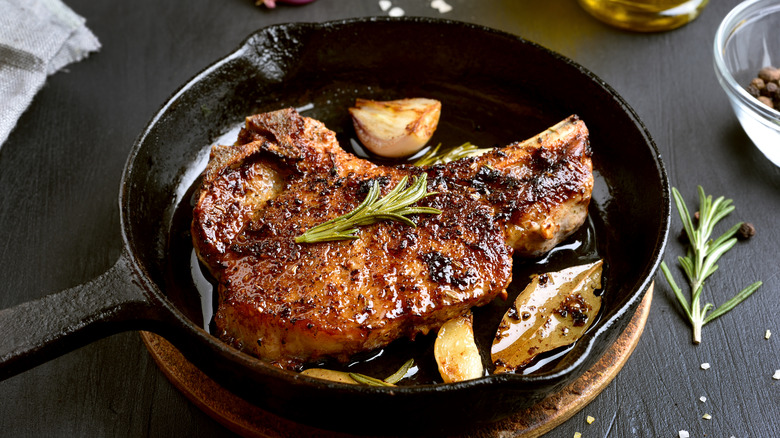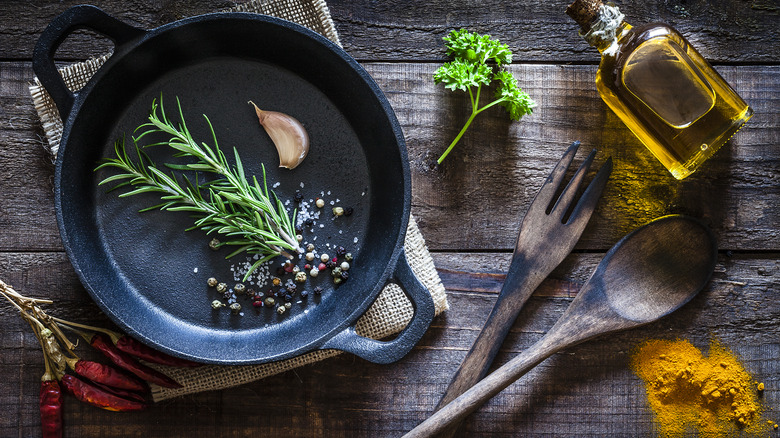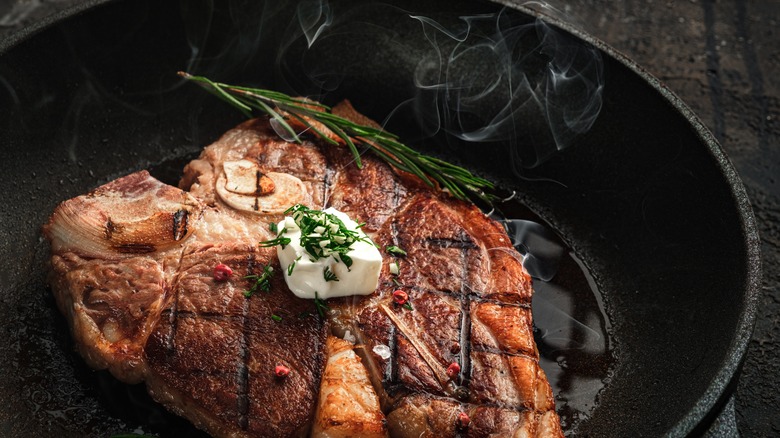How Important Is A Cast Iron Pan For Good Seared Steak?
There's a whole world of ways to cook a perfect steak, from grilling and sous-vide to broiling. Yet, the most popular by far is searing it in a good ol' pan. It's not only the simplest way to cook a steak on the stovetop but also one of the quickest. With searing, there's no need to wait around for an hour like you might with sous-vide. Instead, sear both sides of a cut of steak for just a few minutes, and you'll have a juicy, tender steak, complete with a beautifully caramelized crust ready to be plated in less than fifteen minutes. That's why chefs like Gordon Ramsay still opt for butter-basting and pan-searing.
However, there's one golden rule that you should stick to if you're going the pan-searing route: Always pick a cast iron pan for the job. Unlike other popular materials like stainless steel, aluminum, or copper, cast iron is more or less unbeatable when it comes to its ability to distribute and retain heat, both of which are crucial for a good sear and a crispy crust on your steak.
Cast iron's popularity isn't just due to nostalgia
With so many fancy pans like non-stick and ceramic out there, using cast iron might seem like a nostalgia-driven choice more than anything practical. But there's solid science behind why cast iron is the preferred cooking tool for pan-seared steak.
Per a study published in Food Studies: An Interdisciplinary Journal that looked into different materials that are used to make skillets, cast iron stands out for its low thermal conductivity and high heat capacity. The low thermal conductivity means the pan will take some time to heat up, but once it does, it gets piping hot, and the heat is distributed evenly across the bottom with very few hotspots. As such, you'll get a very even sear across the whole steak. Additionally, the high heat capacity allows the pan to retain heat long after the burner is turned off. This residual heat continues to cook the steak, even after it's been removed from direct heat.
The study also revealed that cast iron has excellent heat emissivity, meaning it can also radiate a lot of heat. If you're butter-basting or frying herbs along with your meat, even if they're resting on top of the steaks rather than directly touching the bottom of the pan, they'll continue to cook from radiant heat. So, you won't just get a well-seared, juicy steak but browned butter and fragrant herbs, too!
A well-seasoned cast iron pan is naturally non-stick
New cast iron pans don't come with a non-stick coating. Because of this, a lot of people tend to shy away from using them under the belief that if they were to try, their expensive tenderloin would stick fast to the bottom of the pan once seared. The thing is, you're not supposed to be using a cast iron pan that hasn't been seasoned.
Seasoning involves coating the pan with oil and heating it, which creates a natural layer of polymerized fat on the surface. This layer not only prevents sticking but also protects the pan from rust in the long run. Over time and with regular use, a well-seasoned cast iron pan becomes impervious to anything sticky. (It also develops a lovely patina-like texture reminiscent of vintage pans!)
What's even better is that the non-stick property of a seasoned cast iron pan is completely natural, as it's just cooking oil. Unlike synthetic non-stick coatings like Teflon found in many modern pans, the seasoning of cast iron is safe and non-toxic. While it may wear off over time or break down in high heat, it poses no harm. This stands in contrast to Teflon, which can release harmful polymer fumes when heated beyond 570 degrees Fahrenheit, according to WebMD.


